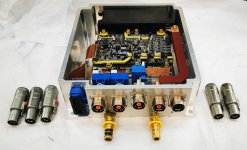HighHopes said:
I have only seen one design feature in any of the OEM inverters I have had in my lab that could not be explained by sound electrical engineering principals and that would be cost accountants cutting current sensor counts from three to two
ya this is pretty common. the text book says you can sum 2 of 3 measurements to zero and thus you don't need the 3rd sensor.. save money. they often miss that you need expensive op-amps because your window of time is much shorter with 2 sensors, but still probably an overall $ saving... cause good sensors are $$.
but here's the interesting part not mentioned in the text books (correct me if i'm wrong, cause i'd LOVE to read a text book on motor control theory that explains this better ).. if you are designing for high performance, which we are, you need 3 sensors because you need to regulate the zero-sequence current so as to squeeze out that extra juice. just to be clear, in a real system especially under extreme dynamics (not steadystate speed) the three sensors may not be balanced and may not even sum to zero (yes that's right, where did the current go if it did not flow to motor and return? huh?). short answer ... use 3 sensors, go after the peak performance, out perform other controllers that tried to save $50 on a $5000 BOM. 8)
The most concise explanation I've found is the infineon appnotes.
https://www.infineon.com/dgdl/Infineon-AP32370_PMSM_FOC_for_XMC1000-AN-v01_00-EN.pdf?fileId=5546d4625b3ca4ec015b3e42761006a8
In this one it explains the relevance of 3 shunts and selecting the correct two for optimal current measurement during the zero vector (that is when all three phases are low, and with phase sensors you can also read in the 7 vector, where all 3 are high). The VESC firmware your using uses a close variant of this, and I can therefore say definitively there is no further magic axiom is applying.
https://www.infineon.com/dgdl/Infineon-TLE987x-Sensorless-Field-Oriented-Control-ApplicationNotes-v01_00-EN.pdf?fileId=5546d46270c4f93e0170f23529817afa
In this one it explains the more budget single shunt method. The two low side shunt method is reliant on duty cycle limitation or control loop cycle skipping.
Neither are especially relevant to axiom since you are using phase inductive sensors which can read the current at any time, they are unaffected by the limitations of shunts, and there is no significant performance advantage to selecting any two, or to using all three. Inductive sensors are essentially immune to switching noise, behaving identically to an oscilloscope current clamp.
Kirchoff's law always holds true, the identity Ia+Ib+Ic=0 is true unless
1) you've suffered insulation failure in your wires or motor
2) you are wired in star and have inexplicably decided to return the centre to ground
It may appear falsely to not be true if
3) your sensors are saturated or broken.
4) you're using a 1990s ADC which is incapable of simultaneous or rapid sampling of multiple phases. (VESC uses a micro with a very good triple ADC)
The real benefit of 3 vs 2 inductive phase sensors is short circuit detection and shut down, where the un sensed phase would have been susceptible to shorts to ground.
This zero sequence (vector) control relates to the timing of the ADC measurements, and assumes (correctly) that the optimal way to read the currents is simultaneously in the exact middle on the pwm cycle (known as the zero or seven vector) where the current is in the exact middle of its decay cycle, and is therefore the linear average current. You could say it is synchronous.
The alternative is asynchronous reading, where you utilise phase shunts to take a reading at any time. This suffers from aliasing with the PWM and requires a lower current bandwidth. It is less applicable to low inductance motors due to the high variation in current at the pwm frequency.
You may also be conflating the zero sequence with the gamma term of the full clark (alpha beta gamma) transform which returns the DC offset. This is useable either as a detection of shorts to ground or as an indicator of the quality of your measurements. It is only applicable to 3 sensor systems.



